Under Armour Bundle
Can Under Armour Rebound in 2025?
Under Armour faces a critical juncture as it reshapes its sales and marketing approach amidst declining revenues and fierce competition. The sportswear giant, seeing a significant drop in sales, is overhauling its strategies to reclaim consumer trust and establish a stronger market position. This strategic shift is crucial for the brand's future, especially as it combats the impact of heavy promotional activity.
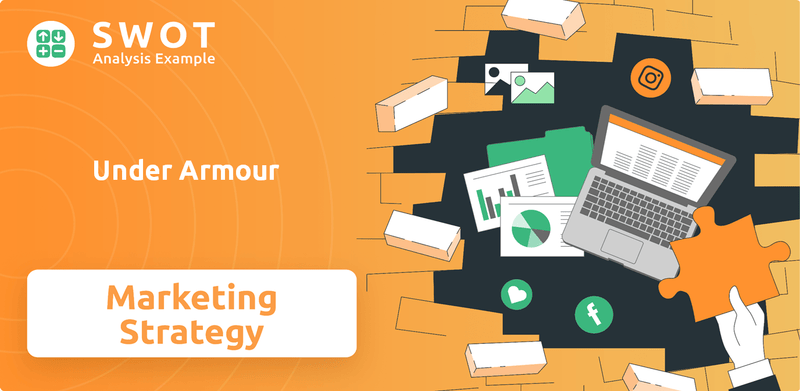
This Under Armour SWOT Analysis reveals the core of its business model and the challenges it faces. Under Armour's sales strategy and marketing strategy are under intense scrutiny, with a focus on its digital marketing strategy and customer acquisition strategy. This analysis will explore how Under Armour is adapting its brand positioning strategy, including its advertising strategy and the effectiveness of its marketing campaign examples, to compete with rivals like Nike and Adidas. Understanding Under Armour's target market and how it plans to use its marketing budget allocation is key to its growth strategy.
How Does Under Armour Reach Its Customers?
The sales channels of the company, reflect a strategic approach that combines both online and offline strategies. Initially, the company relied heavily on wholesale distribution. However, the company has been evolving towards a more balanced and premium distribution model.
The company's sales strategy includes a direct-to-consumer (DTC) approach, which involves its own branded retail stores. This shift began in 2007 and has been a significant part of its sales strategy. Despite the growth in physical retail, the company is also adapting its e-commerce strategy.
The company is focused on optimizing promotional levels and refining segmentation strategies, particularly in the Americas. This is part of a broader effort to enhance brand representation. Additionally, the company is working to streamline its operating model, acknowledging the complexity of its extensive distribution network.
Wholesale distribution remains a key sales channel for the company. This includes partnerships with sporting goods chains, independent retailers, and department stores. In Q1 fiscal 2025, wholesale revenue was at $681 million, marking a decrease of 8%.
The company operates 441 physical retail locations as of Q1 fiscal 2025. DTC revenue in Q1 fiscal 2025 was $480 million, a 12% decrease, influenced by a 25% drop in e-commerce. The company aims to redefine its e-commerce channel.
Online sales accounted for 34% of total DTC sales in Q1 fiscal 2025. The company is reducing promotional activity in e-commerce to prioritize brand equity. This shift is a key part of the overall Competitors Landscape of Under Armour strategy.
The company is focusing on expanding its presence in the EMEA region. It plans to build on its success in the UK and expand into countries like France, Germany, and Spain. The company has over 24,000 points of distribution and approximately 2,000 stores globally.
The company employs a multi-channel sales approach, combining wholesale, DTC retail, and e-commerce. The company is working to optimize promotional levels and segmentation, particularly in the Americas. The company is also focused on team sports to connect with young athletes.
- Wholesale: Significant channel, but revenue decreased in Q1 fiscal 2025.
- DTC Retail: Includes physical stores, with a focus on brand representation.
- E-commerce: Prioritizing brand equity over short-term volume.
- Geographic Expansion: Building on success in the UK to expand in EMEA.
Under Armour SWOT Analysis
- Complete SWOT Breakdown
- Fully Customizable
- Editable in Excel & Word
- Professional Formatting
- Investor-Ready Format
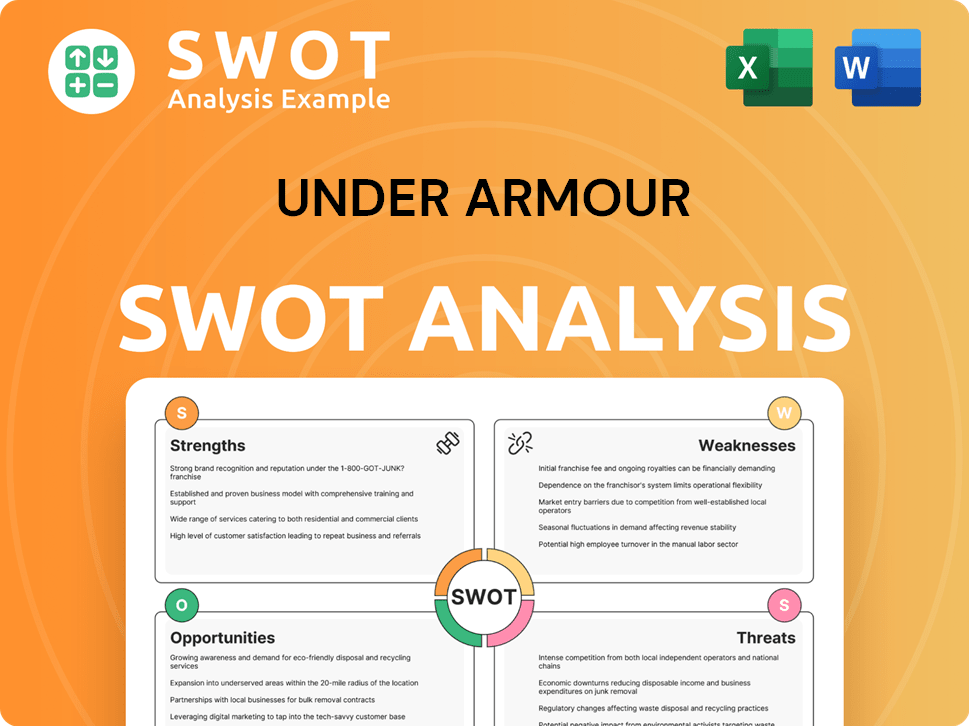
What Marketing Tactics Does Under Armour Use?
The [Company Name] is revamping its marketing approach to boost brand awareness, generate leads, and drive sales. This involves a strategic shift away from heavy discounting towards emphasizing product storytelling and brand building. This Under Armour sales strategy aims to restore the brand to a full-price business model.
The company is investing in a marketing mix that includes both digital and traditional tactics. This includes leveraging social media influencers, enhancing its loyalty program, and connecting with individuals who lead active lifestyles. This strategy is crucial for reaching its
The company is evolving its operating model to be consumer-led, focusing on collaborative alignment across product, marketing, and commercial functions to increase brand affinity. This includes a renewed focus on social commerce platforms and sustainability initiatives.
In 2023, two-thirds of marketing emails included discounts. For fiscal 2025, the goal is to have only one in three emails with promotions. This shift aims to boost full-price sales and enhance brand perception.
The company plans to double its paid social media influencers. This strategy aims to create fresh content and increase customer reach, utilizing
UA Rewards, launched in August 2023, has 5 million members. These members spend 50% more revenue and are three times more likely to make repeat purchases. This is a key component of their
The company emphasizes its mission of 'making athletes better'. They leverage partnerships with athletes, teams, and fitness influencers. This helps in
The company intends to use its $500 million marketing investment more effectively. They are making 'fewer, bolder moves' and using 'micro doses' of marketing. This includes a greater focus on college athletes.
The acquisition of Unless Collective in August 2024 aligns with sustainability goals. The company aims to reduce single-use plastic packaging by 75% by 2025 and use at least 35% recycled polyester in apparel and accessories by 2025.
The company's marketing strategy focuses on several key areas to improve its
- Reduced Discounts: Shifting from heavy discounting to full-price sales.
- Influencer Marketing: Doubling the number of paid social media influencers.
- Loyalty Program: Leveraging UA Rewards to boost customer retention.
- Brand Partnerships: Collaborating with athletes, teams, and fitness influencers.
- Consumer-Led Approach: Aligning product, marketing, and commercial functions.
- Sustainability Initiatives: Reducing plastic and using recycled materials.
Under Armour PESTLE Analysis
- Covers All 6 PESTLE Categories
- No Research Needed – Save Hours of Work
- Built by Experts, Trusted by Consultants
- Instant Download, Ready to Use
- 100% Editable, Fully Customizable
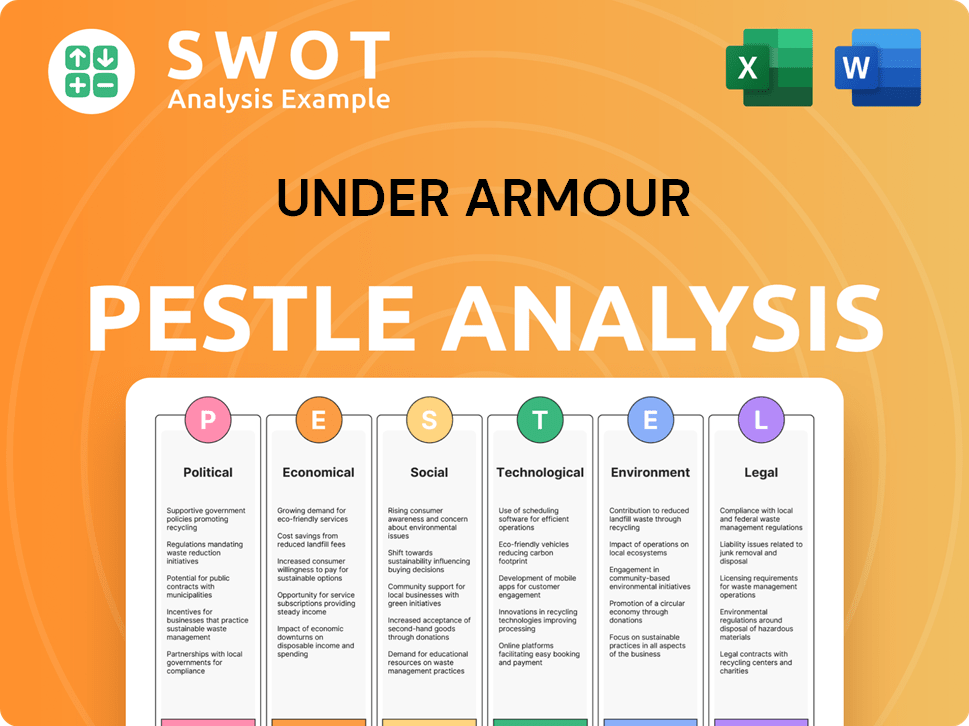
How Is Under Armour Positioned in the Market?
The company is strategically repositioning its brand to compete in the sportswear market. This involves shifting towards a premium image, emphasizing innovation and performance over heavy discounting. The core message focuses on empowering human performance, aiming to be a 'global Sports House' that caters to athletes from head to toe.
The brand's target audience primarily consists of varsity athletes aged 16-24, along with fitness enthusiasts and active individuals. The company aims to embody an 'underdog' identity, fostering resilience and grit through its Sports House positioning in its storytelling. It has successfully built a brand associated with hard work, determination, and achievement.
The visual identity and tone of voice are designed to resonate with this audience, focusing on impactful stories and quality products that evoke emotion. The company is working to improve its storytelling, recognizing its importance in connecting with consumers. The company's commitment to innovation and sustainability is evident in its use of eco-friendly materials, like NEOLAST spandex alternatives, in its product lines.
The company is moving towards a premium brand image. This shift focuses on product innovation and performance attributes. This strategy aims to differentiate the brand in the competitive sportswear market.
The primary target audience is athletes aged 16-24, along with fitness enthusiasts. The brand aims to connect with individuals who embrace an active lifestyle. The brand's messaging is designed to resonate with this demographic.
The brand emphasizes impactful storytelling to connect with its audience. The visual identity and tone of voice are crafted to evoke emotion. The company recognizes the importance of storytelling in its marketing efforts.
The company is integrating eco-friendly materials into its product lines. This includes the use of innovative materials like NEOLAST spandex. This reflects a commitment to sustainability in its product development.
The company's market share in the global sportswear market was 1.9% in 2024. The company is working to enhance brand equity and reconnect with customers. A key part of this strategy is a focus on product innovation and design.
- The company aims to compete with industry leaders like Nike (15.7% market share in 2024) and Adidas (8.2% market share in 2024).
- The focus on product innovation and design aims to increase brand consideration among consumers.
- The emphasis on sustainability, through the use of eco-friendly materials, is a key element of the brand's strategy.
- The company's overall strategy is designed to improve its Growth Strategy of Under Armour.
Under Armour Business Model Canvas
- Complete 9-Block Business Model Canvas
- Effortlessly Communicate Your Business Strategy
- Investor-Ready BMC Format
- 100% Editable and Customizable
- Clear and Structured Layout
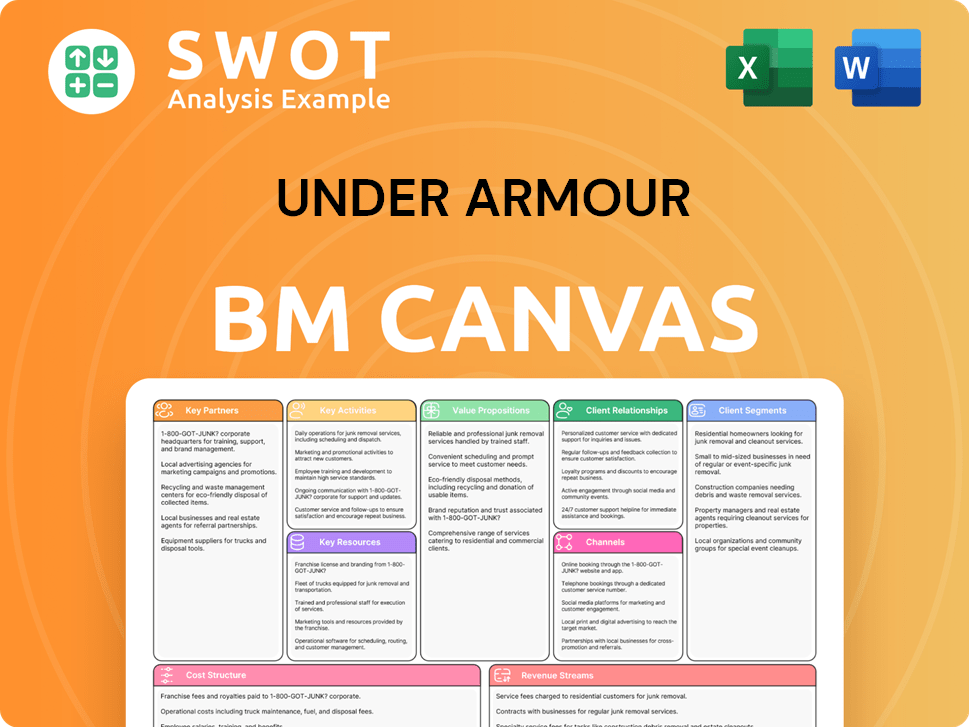
What Are Under Armour’s Most Notable Campaigns?
The company is preparing for a significant marketing push in 2025, as described by CEO Kevin Plank, aiming to revitalize consumer engagement and strengthen its brand. This strategic shift involves reallocating marketing investments towards full-price sales, storytelling, and brand building, moving away from a reliance on discounting. This adjustment follows a period where discounts significantly impacted sales, with approximately 65% of sales in 2023 being driven by promotional pricing.
The company's sales and marketing analysis reveals a focus on connecting with consumers through compelling narratives and innovative product offerings. The goal is to transition from a model heavily reliant on discounts to one that emphasizes the value of its brand and products. This transition is critical for sustainable growth and enhancing the company's position in the competitive athletic apparel market.
The company is looking to tell compelling stories and create products that solve athlete problems, moving beyond just selling on a logo. This customer-centric approach aims to foster deeper connections with consumers and drive long-term brand loyalty, which is a key element of the company's growth strategy. The firm's Under Armour marketing strategy is evolving to better resonate with its target market.
Launched in 2024, the 'Beyond the Game' campaign highlights holistic health, including physical, mental, and emotional well-being. This campaign features diverse athletes, like Simone Biles, who openly discusses her journey toward mental wellness. This resonates with a public increasingly aware of mental health challenges.
The company is revamping the MyFitnessPal app to incorporate mental health features, such as mindfulness exercises and community support forums. This positions the company as a comprehensive health partner. This digital marketing strategy aims to enhance user engagement and brand loyalty.
The company partnered with UNLESS to unveil their first collaborative regenerative collection at Milan Design Week in April 2025. This collection includes plant-based hoodies, t-shirts, and shorts, priced from $30 to $160. This is a key part of the company's e-commerce strategy.
This initiative addresses the industry's reliance on petroleum-based plastics, aligning with rising consumer demand for sustainable activewear. About 73% of Gen Z shoppers prioritize eco-conscious brands. This brand positioning strategy is crucial for long-term success.
The company's marketing strategy focuses on telling compelling stories and creating products that solve athlete problems, moving beyond just selling on a logo. This approach is critical for customer acquisition strategy and long-term brand building.
- Brand Building: Shifting marketing investment toward full-price sales and storytelling to strengthen the brand.
- Holistic Health: The 'Beyond the Game' campaign emphasizes physical, mental, and emotional well-being, resonating with a broader audience.
- Sustainability: Collaboration with UNLESS introduces a regenerative collection, appealing to eco-conscious consumers.
- Digital Engagement: Revamping the MyFitnessPal app to include mental health features enhances user engagement.
For further insights into the company's financial performance and ownership structure, explore the detailed information available at Owners & Shareholders of Under Armour.
Under Armour Porter's Five Forces Analysis
- Covers All 5 Competitive Forces in Detail
- Structured for Consultants, Students, and Founders
- 100% Editable in Microsoft Word & Excel
- Instant Digital Download – Use Immediately
- Compatible with Mac & PC – Fully Unlocked
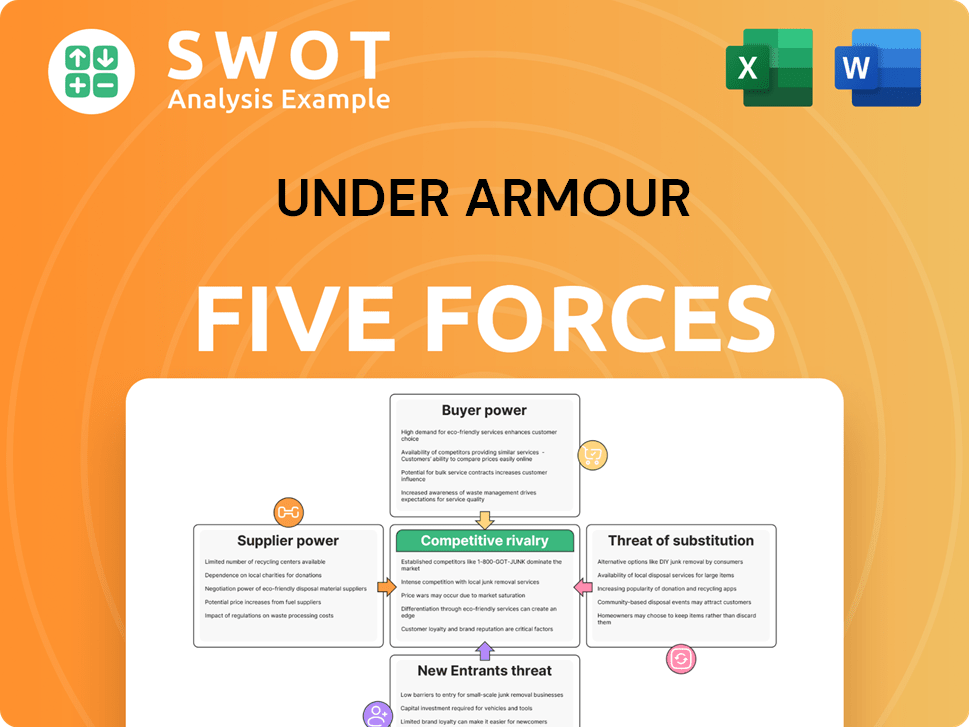
Related Blogs
- What are Mission Vision & Core Values of Under Armour Company?
- What is Competitive Landscape of Under Armour Company?
- What is Growth Strategy and Future Prospects of Under Armour Company?
- How Does Under Armour Company Work?
- What is Brief History of Under Armour Company?
- Who Owns Under Armour Company?
- What is Customer Demographics and Target Market of Under Armour Company?
Disclaimer
All information, articles, and product details provided on this website are for general informational and educational purposes only. We do not claim any ownership over, nor do we intend to infringe upon, any trademarks, copyrights, logos, brand names, or other intellectual property mentioned or depicted on this site. Such intellectual property remains the property of its respective owners, and any references here are made solely for identification or informational purposes, without implying any affiliation, endorsement, or partnership.
We make no representations or warranties, express or implied, regarding the accuracy, completeness, or suitability of any content or products presented. Nothing on this website should be construed as legal, tax, investment, financial, medical, or other professional advice. In addition, no part of this site—including articles or product references—constitutes a solicitation, recommendation, endorsement, advertisement, or offer to buy or sell any securities, franchises, or other financial instruments, particularly in jurisdictions where such activity would be unlawful.
All content is of a general nature and may not address the specific circumstances of any individual or entity. It is not a substitute for professional advice or services. Any actions you take based on the information provided here are strictly at your own risk. You accept full responsibility for any decisions or outcomes arising from your use of this website and agree to release us from any liability in connection with your use of, or reliance upon, the content or products found herein.